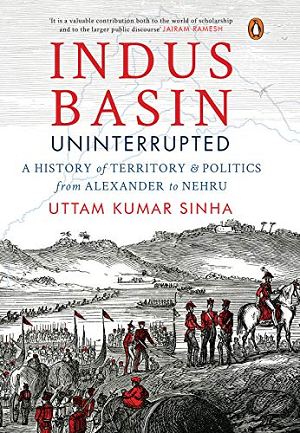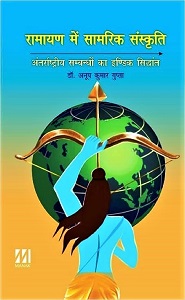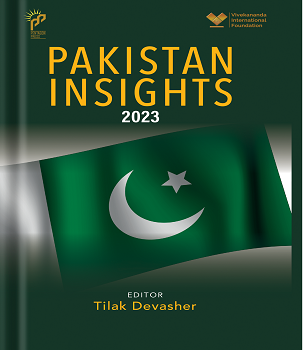The book traces the history of Indus basin from Alexander’s campaign to Muhammad bin Qasim crossing the Indus River and laying the foundation of Muslim rule in India. It follows up providing the Mughal rulers perspective on hydrology and water use, and the British ‘Great Game’ on the Indus basin up to the partition of Indian subcontinent in 1947 and finally the signing of Indus Waters Treaty in 1960. Based on archival records, memoirs, Nehru Papers, World Bank archives and files on the Indus basin dispute, the book comprehensively and uninterruptedly analyses the role and influence of the Indus system of rivers in the Indian sub-continent through history.
Discovery of the ancient sites of Harrapa and Mohenjo-daro uncovered the existence of Indus civilization over 3,500 years ago. Part I of the book brings to fore the historicity of the Indus civilization, Alexander’s triumph over Porus (326 BC) and Muhammad bin Qasim’s conquest of Sindh (711 AD), which marked the advent of Muslim rule in India. Interestingly, centuries later the Jamaat-e-Islami has hailed Qasim as the ‘first Pakistani’ and the heralder of Islam in India. Notices of Sindh and its waters by West Asian travellers like Al-Baladhuri of Baghdad (892-933 AD), El-Masudi (10th century), Alberuni (11th century) and Ibn Batuta (1374 AD) provide an interesting background. That the author has given space to the legendary Suyya (9th century) who resolved the problem of recurrent floods in river Jhelum by demolishing the natural barrier that prevented the flow of water and by building a network of channels and canals in Kashmir, is gratifying. The forgotten Suyya, a common Kashmiri, needs to be remembered by erecting suitable memorial in his honour in the Valley of Kashmir. Similarly, the author credits the Tughlaks (1320-1413 AD) and the Mughals (1526-`1707 AD) for encouraging water harvesting system, digging of new canals and waterways, thus expanding irrigation in the Indus basin.
Part II dealing with ‘Diplomacy and Commerce on the Indus’ during the British period, underlines the role of Minto’s three wise men- John Malcolm, Charles Metcalfe and M. Elphinstone in dealing with the complexities of the ‘region with precarious boundaries’. The British conducted surveys of the Indus, its tributaries and territories with a view to safeguard British interests from any threat from the trans-Indus region. Alexander Burnes with his successful navigation of the Indus in 1831 raised the prospects of navigation and opening of commerce up the Indus, which later led to active British intervention in Sindh and Afghanistan.
Part III - ‘Colonization, Canals and Contestation’ discusses the development of irrigation and canal network in Punjab plains, after its conquest by the British, which changed the socio-economic profile of the region. By last quarter of the 19th century, total cultivable area was 28.11 million acres. By 1900-01, Punjab province had reached a total irrigated area of over 6 million acres. The author gives due credit to the contribution of Indian engineers – M. Visvesvaraya, A.N. Khosla, Sarup Singh and Kanwar Sain , who are described as true practitioners of ‘nationalistic engineering’.
The 1947 ‘Partition of Land and Rivers’ which gave rise to the canal dispute is analysed in Part IV. By the end of partition, the Indus system of rivers fed 36 million acres of irrigated land of which 31 million acres were in West Punjab. The entire Indus basin had a potential to irrigate an additional 46 million acres. And this lay mainly in East Punjab now part of India, which clearly had more requirement for water. Thus arose the canal dispute in 1948 between newly independent India and Pakistan, as upper reaches of the main Indus and its eastern tributaries were now part of India, with Pakistan becoming a lower riparian country. Yet out of 19 head-works and 13 canals in the Indus basin system, only 4 head-works and 2 canals came to East Punjab (India) , the rest going to West Punjab (Pakistan) which also had the large share of the irrigated lands.
The dispute over sharing of waters came to fore immediately after the existing canal head-works of Upper Bari Doab Canal (UBDC) and Sutlej Valley canals fell in India (East Punjab) , while the lands being irrigated by their waters fell in Pakistan’s West Punjab and Bahawalpur State). In order to maintain and run the existing system as before partition, two Standstill Agreements were signed on 20 December 1947 by the Chief Engineers of East Punjab and West Punjab. These interim arrangements were to expire on 31 March 1948, after which East Punjab started asserting its rights on its waters. It was on 1 April 1948 that East Punjab cut off water supplies to Pakistan. Here one would quote the noted British historian and civil servant Rushbrook Williams, who wrote that water supplies were cut “because the canal colonies in Pakistan served by these head-works did not pay the standard water dues”. In the subsequent negotiations held at Simla, two Standstill Agreements were signed on 18 April 1948, which provided for continued supply of water to the Pakistan canals for a limited period and also recognized India’s claims to the UBDC system and Ferozpur head-works. But Pakistan not only did not ratify the Simla Agreement, but mounted pressure on Nehru and also at the UN Security Council on Kashmir. Water supply was restored on 30 April 1948 and Inter Dominion Conference was held at Delhi on 3 May 1948, followed by an agreement on 4 May 1948 whereby East Punjab agreed not to withhold water from West Punjab, which agreed to deposit “with Reserve Bank of India such ad hoc sum as may be specified by the Prime Minister of India”. Though this agreement did provide a basis of dealing with the vexed issue, Pakistan reneged out of it unilaterally saying that it was signed “under duress”. Pakistan was more interested in using the Indus waters dispute as a political tool against India in its battle over Kashmir at the UN. Pakistan sought to create anti-India hysteria, linking the importance of Kashmir’s union with Pakistan to its need to harness its rivers. Whereas India was for bilateral settlement of water dispute, Pakistan from the very beginning was rooting for international intervention.
The author moves on analyzing ‘Making of the Indus Waters Treaty’. He rightly exposes British duplicity and anti-India position on Kashmir and the subsequent US alignment with Pakistan. Whereas Indian Prime Minister Nehru viewed Indus waters dispute as an engineering matter which should be dealt as such, Pakistan’s Prime Minister Liaquat Ali Khan was emphatic that “unless the Kashmir issue is settled, it is unreal to try to settle the issues about water or about evacuees”.
In 1951 David E. Lilienthal, formerly Chairman of Tennessee Valley Authority (TVA) and the U.S. Atomic Energy Commission took active interest in the matter, visiting India and Pakistan, meeting the Prime Ministers of both countries, with the knowledge of the US President Truman and US Secretary of State Dean Acheson. Interestingly around the same time Eugene R. Black, then President of the World Bank and a close friend of Lilienthal, offered the World Bank’s good offices to both India and Pakistan to work out a solution of the Indus waters dispute, which both countries accepted. After a series of meetings, World Bank proposed in 1954 to India and Pakistan the division of rivers- three eastern rivers (Ravi, Beas and Sutlej) for exclusive use of India and the western rivers (Jhelum, Indus and Chenab) for use of Pakistan. Here, one may point out that as to why Kabul River supposed to be part of the Indus basin, was not accounted for while deciding about water sharing. Whereas India accepted the World Bank proposals, Pakistan continued to prevaricate seeking clarifications and taking several years in the negotiations. Finally, Pakistan sought a massive replacement-cum-development package involving an investment of 1.12 billion US dollars. And Pakistan did receive about 870 million US dollars in aid and over 62 million pounds sterling from India. India failed to adjust the debts owed by Pakistan to India. The Indus Waters Treaty was thus signed by India and Pakistan at Karachi in September 1960. Naturally, the terms of the treaty favouring Pakistan, evoked strong criticism from Indian parliamentarians cutting across the party lines, to which Nehru’s answer was ‘unconvincing’. Ironically, the debate in parliament took place after the Treaty was signed and even ratified.
The author is right in saying that “linking the waters in Kashmir and issues of territoriality” still remains an unfinished business in Pakistan. Here in India the treaty is seen to have been unfair in the distribution of water, and also over the massive assistance granted to Pakistan. There is a strong case for review of the provisions of the treaty keeping in view the substantial changes in the ground situation in terms of climate change, demographic pressures and socio-economic changes over the past 60 years. Though the Treaty has no exit clause, “Article X mentioned ‘modification of provisions’ by another duly ratified treaty concluded for that purpose between the two countries”. The Union Territories of Jammu and Kashmir and Ladakh need to be given their legitimate right to full usage of Jhelum, Chenab and Indus waters for hydro-electric generation, irrigation, navigation and other purposes. Both the public and official opinion in Jammu and Kashmir has been that the provisions of the Treaty restricting its use of western rivers have been discriminatory. On 3 April 2002, the J&K Legislative Assembly, cutting across party affiliations, called for a review of the Treaty, as the State has been suffering from acute power shortage in spite of having an untapped hydro-electric potential of 15,000 MW. Besides, the generation of power by the run-of-the-river projects in Kashmir falls by about 70 per cent due to depletion of water level in winters. Similarly, work on the construction of Tulbul Navigation Project started by J&K government in 1984 in order to raise the level of water in the Wullar Lake for facilitating transport on the river Jhelum, was stopped due to objections by Pakistan. Besides, there is the problem of de-silting of Salal dam on the Chenab River. And in Pakistan itself, several Pakistani scholars and public figures have pointed to the problem of water wastage and mismanagement. Pakistan’s portion of Indus basin has been suffering from the problem of water logging and salinity due to excess availability of Indus waters and consequent seepage. At the same time, India needs to have optimum utilization of the provisions of Indus Waters Treaty which allows India the exclusive use of eastern rivers. Part of their water has been flowing into Pakistan. As the author concludes: “A new riparian equation between India and Pakistan would need to be worked out beyond the treaty to ensure that the waters of the Indus basin remain uninterrupted and uninterruptible”. The well researched book is a must read for all those interested in Indo-Pak relations, trans-boundary water issues, and international relations.











Post new comment